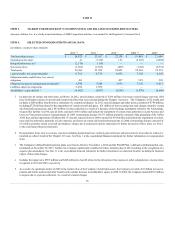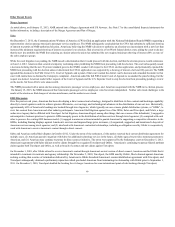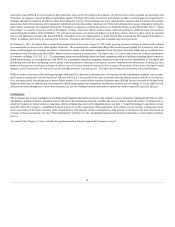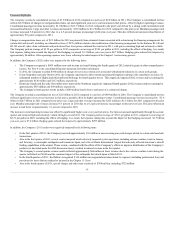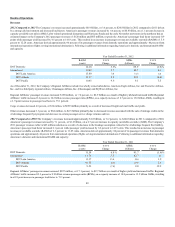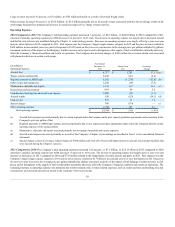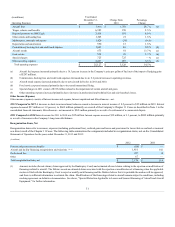American Airlines 2012 Annual Report Download - page 46
Download and view the complete annual report
Please find page 46 of the 2012 American Airlines annual report below. You can navigate through the pages in the report by either clicking on the pages listed below, or by using the keyword search tool below to find specific information within the annual report.
2012 was $1.1 billion, as compared to $697 million during 2011. The increase is primarily the result of a stronger revenue environment and cost savings
resulting from the Company’s Chapter 11 Cases as described in Note 1 to the consolidated financial statements.
The Company made debt and capital lease payments of $1.3 billion and invested $1.9 billion in capital expenditures in 2012. Capital expenditures primarily
consisted of new aircraft and certain aircraft modifications.
Due to the current value of the Company’s derivative contracts, some agreements with counterparties require collateral to be deposited by the counterparty. As
of December 31, 2012, the cash collateral posted by AMR for such counterparties was approximately $0.6 million as compared to cash collateral held of $0.5
million at December 31, 2011. Cash posted at December 31, 2012 is included in other assets. As a result of movements in fuel prices, the cash collateral
amounts held by AMR or the counterparties to such contracts, as the case may be, can vary significantly.As a result of the Terrorist Attacks and the
subsequent liability protections provided for by the Air Transportation Safety and System Stabilization Act (the Stabilization Act), the Company recorded a
liability for the Terrorist Attacks claims equal to the related insurance receivable due to American. The Stabilization Act provides that, notwithstanding any
other provision of law, liability for all claims, whether compensatory or punitive, arising from the Terrorist Attacks, against any air carrier shall not exceed the
liability coverage maintained by the air carrier. In the second quarter of 2011, the Company received $576 million in insurance proceeds as partial settlement
of claims related to the Terrorist Attacks. The Company used these funds to pay a portion of its share of the associated liability. Reflecting this settlement, the
remaining liability, and the amount of the offsetting receivable as of December 31, 2012, were each $1.1 billion.
Compensation On November 27, 2012, the Compensation Committee of the Company's Board of Directors approved the 2013 Annual Short-Term Incentive
Plan (STIP) for non-officer managers of American. This annual bonus plan provides for the payment of awards in the event certain financial metrics are
satisfied. The Company also adopted a profit sharing plan for 2013, which will pay awards to certain employees based on a percentage of pre-tax income.
Working Capital AMR (principally American) historically operates with a working capital deficit. In addition, the Company has historically relied heavily
on external financing to fund capital expenditures. More recently, the Company has also relied on external financing to fund operating losses, employee pension
obligations and debt maturities.
Off Balance Sheet Arrangements American has determined that it holds a significant variable interest in, but is not the primary beneficiary of, certain
trusts that are the lessors under 19 of its aircraft operating leases. These leases contain a fixed price purchase option, which allows American to purchase the
aircraft at a predetermined price on a specified date. However, American does not guarantee the residual value of the aircraft. As of December 31, 2012, future
lease payments required under these leases totaled $98 million.
Certain special facility revenue bonds have been issued by certain municipalities primarily to purchase equipment and improve airport facilities that are leased
by American and accounted for as operating leases. In accordance with various orders of the Bankruptcy Court, special facility revenue bond claims (totaling
approximately $1.1 billion) in connection with the Alliance Airport, Dallas-Fort Worth International Airport and Luis Munoz Marin International Airport in
San Juan are expected to be treated as general unsecured claims. Claims relating to special facility revenue bonds at the Newark Airport (totaling approximately
$18 million) and additional special facility revenue bonds at Luis Munoz Marin International Airport (totaling approximately $36 million) are also expected to
be treated as general unsecured claims. Approximately $486 million of the special facility revenue bonds that had not been compromised as of December 31,
2012 (with total future payments of approximately $822 million as of December 31, 2012) are guaranteed by American, AMR, or both. Approximately $112
million of these special facility revenue bonds contain mandatory tender provisions that require American to make operating lease payments sufficient to
repurchase the bonds in 2014. Although American has the right to remarket the bonds, there can be no assurance that these bonds will be successfully
remarketed. Any payments to redeem or purchase bonds that are not remarketed would generally reduce existing rent leveling accruals or are considered
prepaid facility rentals and would reduce future operating lease commitments.
In addition, the Company had other operating leases, primarily for aircraft and airport facilities, with total future lease payments of 8.1 billion as of
December 31, 2012. Entering into aircraft leases allows the Company to obtain aircraft without immediate cash outflows.
Commitments
American and the American Eagle carriers operate under a capacity purchase agreement, as further described in Item 1, Business. American also contracts
with certain independently owned regional air carriers to provide it with regional feed. The following table summarizes the combined capacity purchase activity
for the American Eagle carriers and the third party regional airlines for 2012 and 2011 (in millions):
46


